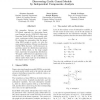119
click to vote
UAI
2008
15 years 2 months ago
2008
We generalize Shimizu et al's (2006) ICA-based approach for discovering linear non-Gaussian acyclic (LiNGAM) Structural Equation Models (SEMs) from causally sufficient, conti...
94
Voted
UAI
2008
15 years 2 months ago
2008
We consider the task of learning mappings from sequential data to real-valued responses. We present and evaluate an approach to learning a type of hidden Markov model (HMM) for re...
133
click to vote
UAI
2008
15 years 2 months ago
2008
In this paper we introduce Refractor Importance Sampling (RIS), an improvement to reduce error variance in Bayesian network importance sampling propagation under evidential reason...
UAI
2008
15 years 2 months ago
2008
116
Voted
UAI
2008
15 years 2 months ago
2008
We address the problem of identifying dynamic sequential plans in the framework of causal Bayesian networks, and show that the problem is reduced to identifying causal effects, fo...
114
Voted
UAI
2008
15 years 2 months ago
2008
Chordal graphs can be used to encode dependency models that are representable by both directed acyclic and undirected graphs. This paper discusses a very simple and efficient algo...
UAI
2008
15 years 2 months ago
2008
We present and evaluate new techniques for designing algorithm portfolios. In our view, the problem has both a scheduling aspect and a machine learning aspect. Prior work has larg...
116
Voted
UAI
2008
15 years 2 months ago
2008
Linear Programming (LP) relaxations have become powerful tools for finding the most probable (MAP) configuration in graphical models. These relaxations can be solved efficiently u...
105
click to vote
UAI
2008
15 years 2 months ago
2008
The paper introduces a generalization for known probabilistic models such as log-linear and graphical models, called here multiplicative models. These models, that express probabi...
105
Voted
UAI
2008
15 years 2 months ago
2008
We present an algorithm that identifies the reasoning patterns of agents in a game, by iteratively examining the graph structure of its Multi-Agent Influence Diagram (MAID) repres...




